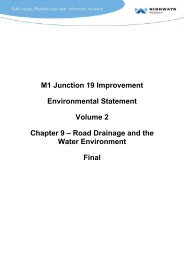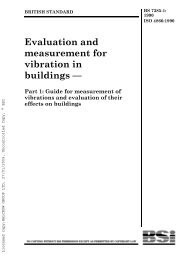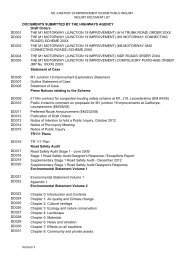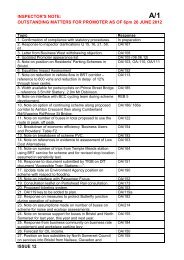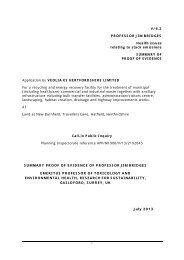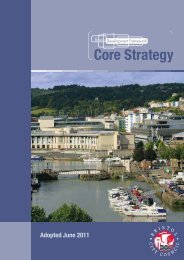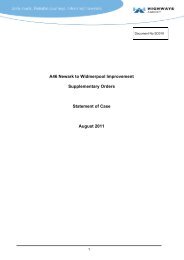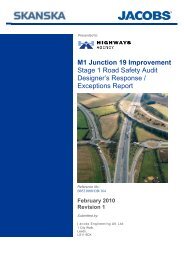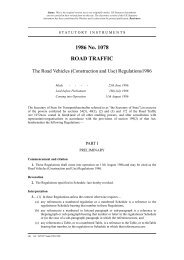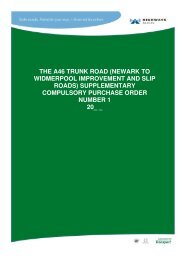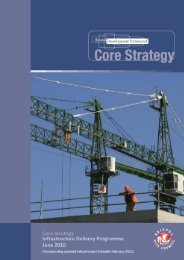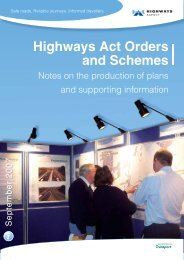Proof of Evidence of Mr James Willcock
Proof of Evidence of Mr James Willcock
Proof of Evidence of Mr James Willcock
You also want an ePaper? Increase the reach of your titles
YUMPU automatically turns print PDFs into web optimized ePapers that Google loves.
Rapid Transit<br />
The Ashton Vale to Temple Meads and Bristol City Centre<br />
Rapid Transit Order<br />
PROOF OF EVIDENCE<br />
<strong>Mr</strong> <strong>James</strong> <strong>Willcock</strong><br />
Procurement Of Services<br />
OA/13<br />
23rd April 2012<br />
Bath & North East Somerset, Bristol, North Somerset and South Gloucestershire<br />
Councils working together to improve your local transport
Document Reference Number OA/13<br />
<strong>Pro<strong>of</strong></strong> <strong>of</strong> <strong>Evidence</strong> <strong>of</strong> <strong>Mr</strong> <strong>James</strong> <strong>Willcock</strong><br />
CONTENTS<br />
1 INTRODUCTION .................................................................................................................. 5<br />
2 OUTLINE OF PROOF OF EVIDENCE ..................................................................................... 6<br />
3 BRT NETWORK OPERATIONAL FRAMEWORK .................................................................... 7<br />
BRT Network Operational Principles ..................................................................................... 7<br />
4 BUS SERVICES LEGAL FRAMEWORK ................................................................................... 9<br />
5 COMMERICAL AND PROCUREMENT ISSUES .................................................................... 11<br />
Bus Operator Engagement ................................................................................................... 12<br />
6 PROCUREMENT OF BUS SERVICES (BRT AND FEEDER BUS SERVICES) ............................ 13<br />
Ashton Vale to Temple Meads (AVTM ) Operational Interface with Bristol Harbour Railway<br />
.............................................................................................................................................. 14<br />
Ashton Vale to Temple Meads (AVTM) Operational Effect on the Existing Bus Network .. 15<br />
Ashton Vale to Temple Meads (AVTM ) BRT Service Operational Benefits ........................ 15<br />
Ashton Vale to Temple Meads (AVTM ) BRT Service Procurement .................................... 16<br />
South Bristol Link (SBL) BRT Service Procurement .............................................................. 16<br />
North Fringe to Hengrove Package (NFHP) BRT Service Procurement ............................... 17<br />
Feeder Bus Services ............................................................................................................. 17<br />
BRT Infrastructure Capacity and BRT Network Level <strong>of</strong> Service .......................................... 18<br />
Quality Partnership Scheme ................................................................................................ 18<br />
Passenger Facilities at BRT Stops ......................................................................................... 20<br />
Procurement <strong>of</strong> BRT and Feeder Bus Services – Milestones ............................................... 20<br />
Procurement Milestones ...................................................................................................... 20<br />
7 SMARTCARD TICKETING SUB-REGIONAL PROJECT DEVELOPMENT ................................ 22<br />
8 REAL TIME PASSENGER INFORMATION (RTPI) ................................................................ 24<br />
Page 2
Document Reference Number OA/13<br />
<strong>Pro<strong>of</strong></strong> <strong>of</strong> <strong>Evidence</strong> <strong>of</strong> <strong>Mr</strong> <strong>James</strong> <strong>Willcock</strong><br />
9 BRT NETWORK OPERATION (MANAGEMENT AND MAINTENANCE) ............................... 25<br />
10 OBJECTIONS ..................................................................................................................... 28<br />
The larger capacity BRT vehicles and concerns about reductions to service frequency<br />
compared with the existing bus service 903 ....................................................................... 28<br />
The seating capacity <strong>of</strong> the BRT vehicles compared with the existing bus service 903,<br />
leading to more passengers not having a seat and having to stand. Such a situation would<br />
reduce comfort for passengers and could lead to lower levels <strong>of</strong> usage ............................ 28<br />
11 STATEMENT OF MATTERS ................................................................................................ 30<br />
12 CONCLUSION .................................................................................................................... 32<br />
Page 3
Document Reference Number OA/13<br />
<strong>Pro<strong>of</strong></strong> <strong>of</strong> <strong>Evidence</strong> <strong>of</strong> <strong>Mr</strong> <strong>James</strong> <strong>Willcock</strong><br />
Page 4
Document Reference Number OA/13<br />
<strong>Pro<strong>of</strong></strong> <strong>of</strong> <strong>Evidence</strong> <strong>of</strong> <strong>Mr</strong> <strong>James</strong> <strong>Willcock</strong><br />
1 INTRODUCTION<br />
1.1 My name is <strong>James</strong> <strong>Willcock</strong>. I am the Strategic Transport Policy & Development<br />
Team Manager for North Somerset Council. I have worked for North Somerset<br />
Council since 2008. My responsibilities include Transport Policy, Transport Data<br />
Unit, Major Transport Schemes, Transport Projects (other than major schemes) and<br />
Development Management (Highways & Transport).<br />
1.2 I hold a BSc (Hons) in Transportation. I have 19 years’ pr<strong>of</strong>essional experience in<br />
transport planning covering a range <strong>of</strong> disciplines including transport and land use<br />
policy; project and programme management; planning, appraisal and procurement<br />
<strong>of</strong> rail and bus infrastructure schemes; management and procurement <strong>of</strong> bus<br />
operations.<br />
1.3 Prior to joining North Somerset Council, I worked for Land Transport New Zealand,<br />
(LTNZ) between 2006 and 2008. LTNZ was the government agency with<br />
responsibility for the national regulation and funding <strong>of</strong> transport, the agency has<br />
now been superseded by the New Zealand Transport Authority. My role as<br />
Manager Programmes for the central region entailed major appraisal and<br />
procurement responsibility for various major rail and bus infrastructure schemes in<br />
Greater Wellington. Before working for LTNZ I worked for Bath & North East<br />
Somerset Council in the capacity <strong>of</strong> Public Transport Team Leader, between 2000<br />
and 2006.<br />
1.4 This <strong>Pro<strong>of</strong></strong> <strong>of</strong> <strong>Evidence</strong> concerns the procurement <strong>of</strong> bus services (Bus Rapid Transit<br />
(BRT) services and feeder bus services) and the BRT network operation including its<br />
on-going management and maintenance. Essentially, my area covers the<br />
operational and commercial aspects <strong>of</strong> the scheme, and the delivery <strong>of</strong> the wider<br />
integrated network <strong>of</strong> BRT and feeder bus services.<br />
1.5 I hereby declare that ins<strong>of</strong>ar as the contents <strong>of</strong> this <strong>Pro<strong>of</strong></strong> <strong>of</strong> <strong>Evidence</strong> are matters<br />
within my knowledge they are true. Ins<strong>of</strong>ar as they are not within my direct<br />
knowledge, they are true to the best <strong>of</strong> my knowledge and belief and are drawn<br />
from documentation and information to which I have had access.<br />
1.6 This <strong>Pro<strong>of</strong></strong> <strong>of</strong> <strong>Evidence</strong> demonstrates the councils have a coherent strategy for the<br />
procurement <strong>of</strong> bus services (BRT services and feeder bus services) and how this is<br />
framed within the overall operational framework for the on-going management<br />
and maintenance <strong>of</strong> the AVTM scheme and further proposed BRT schemes.<br />
Page 5
Document Reference Number OA/13<br />
<strong>Pro<strong>of</strong></strong> <strong>of</strong> <strong>Evidence</strong> <strong>of</strong> <strong>Mr</strong> <strong>James</strong> <strong>Willcock</strong><br />
2 OUTLINE OF PROOF OF EVIDENCE<br />
2.1 I demonstrate in this <strong>Pro<strong>of</strong></strong> <strong>of</strong> <strong>Evidence</strong> that the councils have a coherent strategy<br />
for the procurement <strong>of</strong> bus services (BRT services and feeder bus services) and how<br />
this is framed within the overall operational framework for the on-going<br />
management and maintenance <strong>of</strong> the Ashton Vale to Temple Meads (AVTM) BRT<br />
scheme and further proposed BRT schemes.<br />
2.2 Section 3 <strong>of</strong> this <strong>Pro<strong>of</strong></strong> <strong>of</strong> <strong>Evidence</strong> sets out the strategic procurement context <strong>of</strong><br />
the scheme and what the scheme will deliver; i.e. the operational principles <strong>of</strong> the<br />
scheme.<br />
2.3 Section 4 outlines the legal framework governing the operation <strong>of</strong> local bus services<br />
outside London and the constraints arising from the applicable legislation.<br />
2.4 Sections 5 examines the commercial and procurement issues affecting the councils<br />
(as scheme promoters) and the bus operators (as service providers), and<br />
summarises the commercial context <strong>of</strong> the scheme.<br />
2.5 Section 6 scopes the assessment <strong>of</strong> procurement options for the BRT services and<br />
feeder bus services and the details the preferred option the councils are in the<br />
process <strong>of</strong> taking forward.<br />
2.6 Section 7 sets out the smartcard ticketing strategy, the components <strong>of</strong> the ticketing<br />
<strong>of</strong>fer and the preferred approach for procurement and delivery.<br />
2.7 Section 8 describes the real time passenger information to be provided, how it is to<br />
be procured and how it will be managed.<br />
2.8 Section 9 scopes the operational governance <strong>of</strong> the scheme and identifies three<br />
main functional teams with operational responsibilities.<br />
2.9 Section 10 identifies objections to the draft TWAO that relate to this pro<strong>of</strong> and how<br />
these have been addressed.<br />
2.10 Section 11 assesses the statement <strong>of</strong> matters produced by the Secretary <strong>of</strong> State<br />
for Transport and addresses the main points raised therein.<br />
2.11 Section 12 contains overall conclusions on my evidence.<br />
2.12 A summary <strong>of</strong> my <strong>Pro<strong>of</strong></strong> <strong>of</strong> <strong>Evidence</strong> is provided as OA/13/1 and appendices are<br />
provided as OA/13/2.<br />
Page 6
Document Reference Number OA/13<br />
<strong>Pro<strong>of</strong></strong> <strong>of</strong> <strong>Evidence</strong> <strong>of</strong> <strong>Mr</strong> <strong>James</strong> <strong>Willcock</strong><br />
3 BRT NETWORK OPERATIONAL FRAMEWORK<br />
3.1 In autumn 2011, the four West <strong>of</strong> England (WoE) councils developed a Draft Joint<br />
Procurement Strategy (JPS) (CD/B2) covering the five major transport schemes that<br />
comprise the WoE major scheme programme. The programme consists <strong>of</strong> three<br />
BRT schemes, plus Bath Package and Weston Package which are multi-modal<br />
schemes. The draft JPS (CD/B2) set out three main frameworks to deliver an<br />
integrated BRT network:<br />
BRT Infrastructure Delivery Framework<br />
BRT ITS and Ticketing Delivery Framework<br />
BRT Network Operational Framework<br />
3.2 The draft JPS (CD/B2) identified significant scope for the joint procurement <strong>of</strong><br />
Intelligent Transport Systems (ITS) & Ticketing and BRT Network Operations,<br />
between the three schemes. This joined up procurement approach will provide<br />
economies <strong>of</strong> scale, drive delivery efficiencies and optimise BRT network<br />
integration. Since autumn 2011 the three BRT schemes have undertaken further<br />
engagement with the supply chain, including civil engineering contractors,<br />
hardware and s<strong>of</strong>tware suppliers, bus manufactures and bus operators (OA/13/2,<br />
Appendix 1). This engagement has enabled the three BRT schemes to better<br />
understand the marketplace, and identify the most appropriate procurement<br />
approach and contractual arrangements. The JPS (CD/B2) is currently in the<br />
process <strong>of</strong> being finalised and is programmed to be completed and signed <strong>of</strong>f in<br />
May 2012.<br />
BRT Network Operational Principles<br />
3.3 The three BRT schemes have been developed on the basis <strong>of</strong> scheme wide<br />
principles relating to scheme infrastructure, ITS and Operations. A major theme<br />
has been the need to reduce journey times and to improve journey time reliability.<br />
This principle relates mainly to the provision <strong>of</strong> appropriate BRT infrastructure. The<br />
key difference that sets the BRT schemes aside from conventional highway<br />
infrastructure schemes, is that delivery to the end user requires a major<br />
operational interface, in respect <strong>of</strong> the on-going operation <strong>of</strong> the bus services and<br />
the supporting ITS hardware and s<strong>of</strong>tware. The BRT infrastructure and the ITS<br />
hardware and s<strong>of</strong>tware will be owned and managed by the councils as explained<br />
further.<br />
3.4 The BRT network is to be delivered based on the following operational principles:<br />
Page 7
Document Reference Number OA/13<br />
<strong>Pro<strong>of</strong></strong> <strong>of</strong> <strong>Evidence</strong> <strong>of</strong> <strong>Mr</strong> <strong>James</strong> <strong>Willcock</strong><br />
BRT services will provide an uplift in quality and level <strong>of</strong> service compared with<br />
existing bus services;<br />
The BRT infrastructure will reduce journey times and increase journey time<br />
reliability / punctuality;<br />
Easiness <strong>of</strong> use will be a driving philosophy in the delivery <strong>of</strong> BRT services, this<br />
will involve a wide range <strong>of</strong> factors from level boarding between platform stops<br />
and buses, vehicle features (DDA, on-board information etc.) to convenient<br />
ticketing options and interchange facilities;<br />
BRT infrastructure will be ‘open access’, where any bus operator will be able to<br />
use the BRT infrastructure, subject to adherence to: appropriate quality<br />
standards, minimum levels <strong>of</strong> service, contributing to meeting scheme objectives<br />
and delivery <strong>of</strong> customer service expectations. This may include a combination<br />
<strong>of</strong> competitively tendered and commercial bus services;<br />
All bus operators are to sign up to a joint branding and marketing agreement, to<br />
assist the integrated delivery <strong>of</strong> the BRT network and wider bus network;<br />
BRT services are not projected to require on-going subsidy after the initial period<br />
to establish services. Any revenues from services that generate an operating<br />
surplus will be reinvested back into the public transport network;<br />
Boarding times (Stop dwell times) will be minimised through the rollout <strong>of</strong> a BRT<br />
network wide smartcard ticketing system, as part <strong>of</strong> a wider sub-regional<br />
smartcard ticketing project;<br />
Fares will be competitive compared with non-public transport modes;<br />
There will be an ethos <strong>of</strong> delivering and maintaining high quality customer<br />
service, through both traditional methods and the use <strong>of</strong> smart technology; and<br />
The combined delivery <strong>of</strong> the BRT infrastructure, ITS & Ticketing and BRT<br />
services will achieve the establishment <strong>of</strong> an integrated BRT network, together<br />
with improvements to the wider bus network.<br />
3.5 The BRT Network Operational Framework will comprise work streams for the<br />
delivery and on-going operation <strong>of</strong> the AVTM BRT Scheme and the subsequent BRT<br />
schemes; South Bristol Link and North Fringe to Hengrove Package, that together<br />
form the basis <strong>of</strong> the BRT Network. These work streams include:<br />
Procurement <strong>of</strong> Bus Services (BRT Services and Feeder Bus Services); and<br />
BRT Network Operation (Management and Maintenance).<br />
Page 8
Document Reference Number OA/13<br />
<strong>Pro<strong>of</strong></strong> <strong>of</strong> <strong>Evidence</strong> <strong>of</strong> <strong>Mr</strong> <strong>James</strong> <strong>Willcock</strong><br />
4 BUS SERVICES LEGAL FRAMEWORK<br />
4.1 The marketplace for the provision and operation <strong>of</strong> local bus services was<br />
deregulated outside London in 1986, through the Transport Act 1985, later<br />
amended by the Transport Act 2000 and the Local Transport Act 2008. Bus<br />
operators are free to determine the services they wish to operate, including the<br />
route, the service frequency, the fares and other operational matters, on a<br />
commercial basis, subject to certain minimum requirements. Local transport<br />
authorities have powers to procure bus services where there is no commercial<br />
provision and to enhance the level <strong>of</strong> service provided commercially, subject to<br />
legislative provisions.<br />
4.2 The minimum requirement for a commercial bus operator to run a bus service is to<br />
register the particulars (route, timetable etc.) with the Traffic Commissioner at<br />
least 56 days before the start <strong>of</strong> operation. There is no automatic obligation for a<br />
bus operator to adhere to a network or service standard prescribed by the local<br />
transport authority, unless specified by a contract or where an authority has been<br />
successful in invoking legislative provisions controlling the use <strong>of</strong> specific transport<br />
infrastructure, through a Quality Partnership Scheme (QPS). The four councils <strong>of</strong><br />
the West <strong>of</strong> England implemented Quality Partnership Schemes in 2011 and 2012<br />
on 10 showcase bus corridors, which comprise the Greater Bristol Bus Network<br />
major scheme. Each Quality Partnership Scheme entails requirements upon bus<br />
operators known as the Standard <strong>of</strong> Services (e.g. service frequency etc.), in return<br />
for which the councils are required to provide the Facilities (e.g. bus priority<br />
measures etc.). The Quality Partnership Scheme for corridor 8, which includes bus<br />
service X1, 352 and 353 is included as Appendix 2 in OA/13/2.<br />
4.3 Clearly, bus operators are commercially focused and their decision making in<br />
respect <strong>of</strong> the allocation <strong>of</strong> resources (vehicle, drivers and supporting systems) is<br />
based around the need to ensure that there are sufficient farebox revenue streams<br />
to cover all their costs and provide an operating pr<strong>of</strong>it. Moreover, the councils<br />
need to have confidence that the BRT services and feeder bus services will be<br />
provided upon the opening for the BRT schemes, in line with the councils’<br />
objectives and operational principles and will continue on an on-going basis.<br />
4.4 The proposed BRT network is based around a number <strong>of</strong> existing bus services, some<br />
<strong>of</strong> which are provided by bus operators on a commercial basis and some <strong>of</strong> which<br />
are provided under contract to the councils. Also, parts <strong>of</strong> the proposed BRT<br />
network are entirely new services. Given the mix <strong>of</strong> existing commercial and<br />
contracted bus services, the councils have worked in partnership with the bus<br />
Page 9
Document Reference Number OA/13<br />
<strong>Pro<strong>of</strong></strong> <strong>of</strong> <strong>Evidence</strong> <strong>of</strong> <strong>Mr</strong> <strong>James</strong> <strong>Willcock</strong><br />
operators and will continue to do so to achieve a balance between commercial<br />
interests and delivering the scheme principles to the public.<br />
Page 10
Document Reference Number OA/13<br />
<strong>Pro<strong>of</strong></strong> <strong>of</strong> <strong>Evidence</strong> <strong>of</strong> <strong>Mr</strong> <strong>James</strong> <strong>Willcock</strong><br />
5 COMMERICAL AND PROCUREMENT ISSUES<br />
5.1 The proposed BRT service for the AVTM scheme is to replace the existing Long<br />
Ashton Park & Ride service 903, therefore the BRT service will not be an entirely<br />
new service. While the route <strong>of</strong> the AVTM BRT service will differ from service 903,<br />
the origin and destination are the same. Therefore the commercial starting point<br />
for the AVTM BRT is based on the known current passenger trips made on service<br />
903. Furthermore, service 903 is currently provided under contract to Bristol City<br />
Council (via competitive tender).<br />
5.2 The local marketplace for bus services is moderately buoyant, there are two large<br />
bus operators First and Wessex Connect, with several smaller operators providing<br />
commercial and contracted bus services in the area. There is a good degree <strong>of</strong><br />
competition for contracted bus services. In the most recent tender rounds for Park<br />
and Ride services (including the Long Ashton Park and Ride) an average <strong>of</strong> five<br />
tender bids were received. Commercial bus service competition is more limited and<br />
there is only limited route competition between bus operators for bus services<br />
along corridors between Bristol and North Somerset, except in the city centre on<br />
overlapping sections <strong>of</strong> bus routes.<br />
5.3 There are no concerns over the capacity and appetite <strong>of</strong> the marketplace to deliver<br />
the BRT services and corridor bus services. The underlying local factors and<br />
dynamics are such that there is an effective marketplace for contracted services<br />
while the extent <strong>of</strong> commercial bus service competition is more limited. Taking<br />
account <strong>of</strong> this local context in consideration <strong>of</strong> the procurement options has led us<br />
to conclude that the efficiency and effectiveness <strong>of</strong> the bus service marketplace<br />
would not be materially affected whether services are provided on a contracted or<br />
a commercial basis.<br />
5.4 The draft JPS (CD/B2) entailed a procurement options appraisal, where options<br />
were assessed and scored based upon the operational context <strong>of</strong> each BRT scheme.<br />
For the AVTM scheme, the draft JPS (CD/B2) recommends the procurement <strong>of</strong> the<br />
BRT service under contract via a competitive tender. This effectively is a<br />
continuation <strong>of</strong> the existing approach for service 903, which is contracted via<br />
competitive tender. This approach has the advantage that it manages the<br />
commercial risks to both the councils and the bus operators, very effectively. The<br />
delivery <strong>of</strong> the AVTM BRT service will require investment by the operator in a<br />
minimum <strong>of</strong> 5 vehicles for an ‘every 6 minutes’ service frequency. This represents a<br />
considerable investment in respect <strong>of</strong> capital outlay or lease arrangement in the<br />
Page 11
Document Reference Number OA/13<br />
<strong>Pro<strong>of</strong></strong> <strong>of</strong> <strong>Evidence</strong> <strong>of</strong> <strong>Mr</strong> <strong>James</strong> <strong>Willcock</strong><br />
order <strong>of</strong> £1m to £1.5m. For an operator to have confidence to commit to such an<br />
investment there needs to be a degree <strong>of</strong> certainty that the infrastructure will be in<br />
place when the vehicles are delivered. The councils equally need to have<br />
confidence that an operator will commit to timely investment in vehicles, so that<br />
vehicles are delivered in time for the completion <strong>of</strong> infrastructure and scheme<br />
opening. A competitive tender approach for the procurement <strong>of</strong> the AVTM BRT<br />
service would align the requirements <strong>of</strong> each party and would have the advantage<br />
<strong>of</strong> reducing risks to both the operator and the councils.<br />
Bus Operator Engagement<br />
5.5 The councils have met with both the incumbent bus operators and major national<br />
bus operators, to explain the objectives <strong>of</strong> the BRT schemes and seek input on<br />
taking forward the BRT Network Operational Framework. In July 2011 the councils<br />
held a bus operator engagement day, inviting major national bus operators. The<br />
event was attended by five national operators; First, Stagecoach, National Express,<br />
Go Ahead and Wessex Connect (Rotala). All five operators support the proposed<br />
investment in infrastructure to enable the establishment <strong>of</strong> a BRT network for the<br />
sub-region. Letters <strong>of</strong> support are set out in Appendix 1, OA/13/2. The process <strong>of</strong><br />
consultation and engagement will continue through 2012 and thereafter. Further<br />
details about the timescales for the procurement <strong>of</strong> BRT and feeder bus services<br />
are set out in Section 6.<br />
Page 12
Document Reference Number OA/13<br />
<strong>Pro<strong>of</strong></strong> <strong>of</strong> <strong>Evidence</strong> <strong>of</strong> <strong>Mr</strong> <strong>James</strong> <strong>Willcock</strong><br />
6 PROCUREMENT OF BUS SERVICES (BRT AND FEEDER BUS<br />
SERVICES)<br />
6.1 The purpose <strong>of</strong> the Procurement <strong>of</strong> Bus Services (BRT Services and Feeder Bus<br />
Services) work stream is to procure the delivery <strong>of</strong> both BRT services and feeder<br />
bus services for the three BRT schemes, through a combination <strong>of</strong> competitive<br />
tender and via the commercial marketplace. The BRT services will form the core<br />
services to be operated on the BRT infrastructure. The feeder bus services are<br />
existing bus services that will use parts <strong>of</strong> the BRT infrastructure to obtain journey<br />
time savings.<br />
6.2 This work stream includes OJEU procurement, the formulation <strong>of</strong> a Quality<br />
Partnership Scheme and complementary legal agreements, informs the design <strong>of</strong><br />
the ‘BRT Network Operation (Management and Maintenance)’ work stream, which<br />
concerns the on-going operational management and maintenance <strong>of</strong> the BRT<br />
services, ITS and infrastructure. Central to the delivery <strong>of</strong> both work streams is<br />
integration; this includes integration between the schemes, physical and technical<br />
integration and integration with the wider bus network.<br />
6.3 Procurement <strong>of</strong> Bus Services (BRT Services and Feeder Bus Services) work stream<br />
entails three main categories <strong>of</strong> bus service:<br />
a) Procurement <strong>of</strong> BRT services via competitive tender<br />
b) Procurement <strong>of</strong> BRT services via commercial marketplace<br />
c) Procurement <strong>of</strong> Feeder bus services via commercial marketplace<br />
6.4 Table 1, (OA13/2, Appendix 3) provides a network wide summary by service type<br />
and scheme. The AVTM BRT scheme entails bus categories a) and c) only, while the<br />
NFHP scheme entails all three.<br />
6.5 The BRT services will form the core services to be operated on the BRT<br />
infrastructure. The BRT services will be characterised by an uplift in quality and<br />
level <strong>of</strong> service compared with conventional bus services, through the delivery <strong>of</strong><br />
the BRT infrastructure, ITS and the levels <strong>of</strong> service and operational standards<br />
prescribed by the councils. The core BRT services will operate at high frequency,<br />
typically operating between every 10 minutes, and in the case <strong>of</strong> the AVTM BRT<br />
service an every 6 minute frequency is proposed. To ensure the provision <strong>of</strong> a<br />
consistent quality uplift and high levels <strong>of</strong> service, the BRT services will be the only<br />
services serving Park & Ride customers, at least during the initial period to establish<br />
the BRT services. For example the AVTM BRT service will be the only service<br />
Page 13
Document Reference Number OA/13<br />
<strong>Pro<strong>of</strong></strong> <strong>of</strong> <strong>Evidence</strong> <strong>of</strong> <strong>Mr</strong> <strong>James</strong> <strong>Willcock</strong><br />
operating into Long Ashton Park & Ride site, initially. The councils will review this<br />
policy periodically to determine whether customer service could be enhanced<br />
overall by allowing non BRT services to use the Park & Ride site.<br />
6.6 The feeder bus services will comprise largely <strong>of</strong> existing commercial bus services<br />
that are to use the BRT infrastructure to obtain journey time savings, thereby<br />
enhancing the attractiveness <strong>of</strong> the wider bus network and contributing towards<br />
the councils’ modal shift objectives. The feeder bus services will generally either<br />
operate at lower frequency e.g. every half an hour and operate typically longer<br />
distances e.g. 20 mile town to city services, or they will operate at relatively high<br />
frequency mainly urban services e.g. every 10 minutes but only use part <strong>of</strong> the BRT<br />
infrastructure.<br />
6.7 AVTM is the first <strong>of</strong> the three BRT schemes to be delivered, with BRT operations<br />
programmed to commence in summer 2015. SBL follows in summer <strong>of</strong> 2016 and<br />
NFHP opens in 2017. Physically the three schemes connect together at the<br />
following locations (see OA/13/2, Appendix 4):<br />
Approx 100 metres to the east <strong>of</strong> the Long Ashton P&R site SBL connects with<br />
AVTM via bus only T junction;<br />
AVTM, SBL and NFHP BRT services all converge in Bristol city centre between<br />
Cabot Circus, Broadmead, Colston Avenue, Broad Quay and Prince Street,<br />
running on extended bus lanes; and<br />
At Hengrove Park, SBL BRT services share an interchange with NFHP BRT<br />
services.<br />
Ashton Vale to Temple Meads (AVTM ) Operational Interface with Bristol Harbour<br />
Railway<br />
6.8 Between the CREATE Centre and the MShed the AVTM inbound busway shares the<br />
Bristol Harbour Railway (BHR) alignment when the Harbour Railway is not in<br />
operation. The Bristol Harbour Railway is a heritage railway operating on summer<br />
Sundays and public holidays only. On the occasions when the heritage railway is<br />
used, inbound buses will use the Cumberland Road carriageway. The outbound<br />
alignment will run on a new bus lane along Cumberland Road. The tracks for the<br />
heritage railway would be relaid within the single guided busway to allow heritage<br />
rail services to continue to operate on Summer Sundays and public holidays. The<br />
existing fence between Cumberland Road and the heritage railway would be<br />
removed to aid construction and would be replaced with a suitable alternative.<br />
New guard rail, stops and station platforms would be constructed close to Vauxhall<br />
Bridge to serve SS Great Britain. Where possible existing heritage features are to be<br />
retained or incorporated into the scheme. Appropriate materials will be used<br />
Page 14
Document Reference Number OA/13<br />
<strong>Pro<strong>of</strong></strong> <strong>of</strong> <strong>Evidence</strong> <strong>of</strong> <strong>Mr</strong> <strong>James</strong> <strong>Willcock</strong><br />
which match the surrounding materials, such as pennant stone walls and metal<br />
work, so that the character is retained and enhanced where possible. The small<br />
scale railway features, which make an important contribution to the character <strong>of</strong><br />
the area, would be retained and re-used. For further detail regarding the<br />
engineering interface <strong>of</strong> the heritage railway with the AVTM bus-way refer to the<br />
<strong>Pro<strong>of</strong></strong> <strong>of</strong> <strong>Evidence</strong> <strong>of</strong> <strong>Mr</strong> Bruce Slattery OA/4 covering scheme Engineering.<br />
Ashton Vale to Temple Meads (AVTM) Operational Effect on the Existing Bus<br />
Network<br />
6.9 As part <strong>of</strong> the engagement with bus operators during the development <strong>of</strong> the<br />
AVTM scheme, First Group have made an initial commitment to divert services X1,<br />
354 and 361 which currently operate between North Somerset and Bristol<br />
Marlborough Street Bus Station, onto the guided section <strong>of</strong> the AVTM Scheme<br />
before continuing via Prince Street onto their current route; and hence would gain<br />
the benefits <strong>of</strong> journey time savings between the A370 and the Centre. The<br />
diversion <strong>of</strong> the three services from Hotwell Road would therefore be a potential<br />
impact on passengers currently travelling along the corridor.<br />
6.10 Firstly, the diversion <strong>of</strong> the three services from Hotwell Road would still leave a<br />
number <strong>of</strong> services continuing to operate along the corridor. Excluding the Park<br />
and Ride services to Portway, there would still be 8 buses per hour in the peak<br />
along Hotwell Road, as well as bus service 505 and 506 operating along part <strong>of</strong><br />
Anchor/Hotwell Road to Southmead Hospital, which are unaffected. Secondly, the<br />
number <strong>of</strong> passengers using the X1, 354 and 361 services to travel within the<br />
Hotwell Road corridor is small – most passengers travel through the corridor<br />
between North Somerset and central Bristol. Further information about existing<br />
usage <strong>of</strong> bus service X1, 354 and 361 is contained in <strong>Mr</strong> Rob Thompson’s <strong>Pro<strong>of</strong></strong> <strong>of</strong><br />
<strong>Evidence</strong> OA/6.<br />
Ashton Vale to Temple Meads (AVTM ) BRT Service Operational Benefits<br />
6.11 The BRT service is proposed to operate up to every 6 minutes (10 services per<br />
hour). The investment in the BRT infrastructure will cut journey times, thereby<br />
reducing bus operating costs. The existing park & ride service 903 operates a<br />
service frequency <strong>of</strong> every 10 minutes in the AM peak and every 7 minutes in the<br />
PM peak, with a peak vehicle requirement <strong>of</strong> 6 vehicles. The AVTM BRT service in<br />
comparison will operate every 6 minutes in the AM and PM peaks and has a peak<br />
vehicle requirement <strong>of</strong> 5 vehicles. A saving <strong>of</strong> 1 vehicle from the 6 to 5 vehicles<br />
represents a 16% reduction in vehicle operating costs, while also yielding a 66%<br />
increase in service frequency in the AM peak and 16% increase in the PM peak.<br />
Page 15
Document Reference Number OA/13<br />
<strong>Pro<strong>of</strong></strong> <strong>of</strong> <strong>Evidence</strong> <strong>of</strong> <strong>Mr</strong> <strong>James</strong> <strong>Willcock</strong><br />
6.12 While the current service 903 is a successful service carrying approximately 500,000<br />
passenger per annum, it requires on-going subsidy. As a result <strong>of</strong> the BRT<br />
infrastructure, the transport modelling forecasts passenger demand from Long<br />
Ashton Park & Ride site increases from 600 passengers in the AM peak hour in 2016<br />
to 850 passengers by 2031, representing growth <strong>of</strong> over 35%. The modelling<br />
forecasts that fare-box revenue in 2016 will cover the estimated BRT service<br />
operating costs. However, including various standing costs such as site security,<br />
business rates, electricity and park & ride site maintenance, indicates that the<br />
service will continue to require a residual subsidy during the first 3 years <strong>of</strong><br />
operation. Thereafter the service is forecast to produce a modest net operating<br />
surplus which will be reinvested back into the public transport network. Further<br />
information about the forecast passenger demand can be found in <strong>Mr</strong> Rob<br />
Thompson’s <strong>Pro<strong>of</strong></strong> <strong>of</strong> <strong>Evidence</strong> OA/6.<br />
Ashton Vale to Temple Meads (AVTM ) BRT Service Procurement<br />
6.13 As set out in paragraphs 6.3 and 6.4 the preferred option to procure the AVTM BRT<br />
service is via competitive tender. The award <strong>of</strong> a contract to operate the Rapid<br />
Transit service would enable the operator to underwrite investment in vehicles on<br />
the basis (£ value) <strong>of</strong> the contract, thereby resulting in reduced financial exposure<br />
compared with a commercially led investment. The award <strong>of</strong> a contract to operate<br />
the BRT service would give the councils greater control over co-ordination between<br />
the procurement work streams; the delivery <strong>of</strong> infrastructure, delivery <strong>of</strong> the ITS &<br />
Ticketing and the delivery <strong>of</strong> the service. It would equally enable the councils to<br />
have greater confidence that the operator will make timely investment in vehicles,<br />
providing a greater level <strong>of</strong> confidence for managing the transition from the<br />
existing park & ride service to the new AVTM BRT service. It would also provide<br />
greater certainty regarding the continuity <strong>of</strong> service provision.<br />
South Bristol Link (SBL) BRT Service Procurement<br />
6.14 The most efficient way to provide the BRT service for South Bristol Link is to extend<br />
some <strong>of</strong> the AVTM BRT vehicles to Hengrove Park, i.e. an inter-worked operation.<br />
The preferred option for the procurement <strong>of</strong> the SBL BRT service is to include it as<br />
an extension to the AVTM BRT service contract. Therefore when SBL opens in<br />
2016, the AVTM BRT service contract will be extended and additional vehicles will<br />
be provided to enable a through service to Hengrove Park. Extending one in three<br />
<strong>of</strong> the AVTM BRT services to Hengrove Park will provide an SBL BRT service<br />
frequency <strong>of</strong> every 18 minutes in the peak.<br />
Page 16
Document Reference Number OA/13<br />
<strong>Pro<strong>of</strong></strong> <strong>of</strong> <strong>Evidence</strong> <strong>of</strong> <strong>Mr</strong> <strong>James</strong> <strong>Willcock</strong><br />
North Fringe to Hengrove Package (NFHP) BRT Service Procurement<br />
6.15 The BRT service for NFHP comprises <strong>of</strong> a range <strong>of</strong> BRT services, most <strong>of</strong> which are<br />
likely to be provided on a commercial basis. Some <strong>of</strong> the NFHP BRT services will be<br />
provided initially, via competitive tender using pump-prime funding, to secure<br />
service provision to on-going residential and commercial development sites. The<br />
proposed AVTM BRT competitive tender will provide an opportunity to procure<br />
some <strong>of</strong> the NFHP BRT services, as well as the SBL BRT services, within one<br />
contract.<br />
Feeder Bus Services<br />
6.16 The AVTM feeder bus services will be procured in negotiation with the existing<br />
commercial service providers. Three feeder bus services have been identified to<br />
make use <strong>of</strong> the AVTM bus-way, these are the:<br />
X1 operating between Weston-super-Mare and Bristol every half an hour<br />
354 operating between Nailsea and Bristol every half an hour, and<br />
361 operating between Clevedon and Bristol every hour.<br />
In 2016 when South Bristol Link (SBL) opens, the existing airport shuttle service<br />
A1 & A2 known as the ‘Airport Flyer’, operating between Bristol Airport and<br />
Bristol Temple Meads and city centre, will join the SBL infrastructure at the A38<br />
and operate onto the AVTM bus-way at the SBL / AVTM bus only T junction to<br />
the east <strong>of</strong> the Long Ashton Park & Ride site and into Bristol city centre. The<br />
‘Airport Flyer’ currently operates every 10 minutes throughout the day time<br />
Monday to Saturday and every 15 minutes on Sundays. For the NFHP BRT<br />
scheme, the extent <strong>of</strong> feeder bus services to use BRT infrastructure is subject to<br />
further engagement with bus operators.<br />
6.17 The incentive for the commercial bus operators to divert these services onto BRT<br />
infrastructure, is to reap journey time savings which directly reduce bus operating<br />
costs and stimulate passenger demand. Further information about journey time<br />
savings can be found in <strong>Mr</strong> Rob Thompson’s <strong>Pro<strong>of</strong></strong> <strong>of</strong> <strong>Evidence</strong> OA/6.. While the<br />
feeder bus services will also be required to adhere to minimum quality standards,<br />
these standards may be less stringent than the uplift required for the BRT services,<br />
as they will continue to be branded and operate as conventional bus services. All<br />
bus operators wishing to use the AVTM busway will be required to fit guidance<br />
wheels to the front <strong>of</strong> buses, at the bus operators cost. The councils will provide<br />
bus operators with the technical specification for the guidance wheels. The<br />
experience from the Cambridge busway scheme is that the cost <strong>of</strong> fitting guidance<br />
Page 17
Document Reference Number OA/13<br />
<strong>Pro<strong>of</strong></strong> <strong>of</strong> <strong>Evidence</strong> <strong>of</strong> <strong>Mr</strong> <strong>James</strong> <strong>Willcock</strong><br />
wheels is minimal. The cost <strong>of</strong> maintenance, repair and cleaning <strong>of</strong> BRT<br />
infrastructure and ITS may be recouped from bus operators via a small access<br />
charge levied by the councils. Naturally, any access charge will need to be lower<br />
than the comparative operational cost saving to the bus operators arising from<br />
diverting bus services into BRT infrastructure.<br />
BRT Infrastructure Capacity and BRT Network Level <strong>of</strong> Service<br />
6.18 Approximately 85% <strong>of</strong> the AVTM BRT alignment is physically segregated from<br />
general traffic. The percentage segregation for SBL and NFHP is lower, this is<br />
because the scheme context is different for each scheme. The AVTM BRT<br />
alignment provides for a lane in each direction, i.e. two way operations except for<br />
at: Ashton Avenue Swing bridge, Cumberland Road bridge and Prince Street bridge.<br />
At these locations where there is reduced lane width, buses will operate shuttle<br />
working under signal control. The length <strong>of</strong> shuttle working varies from 60 metres<br />
to 220 metres. The capacity <strong>of</strong> BRT infrastructure at these locations has been<br />
tested using a micro-simulation model, based on the proposed levels <strong>of</strong> service<br />
(number <strong>of</strong> buses) <strong>of</strong> the BRT services and feeder bus services.<br />
6.19 The total level <strong>of</strong> service on the AVTM bus-way will be 15 buses per hour in each<br />
direction in the peak, which is equivalent to one every 4 minutes. When South<br />
Bristol Link (SBL) opens in 2016, the ‘Airport Flyer’, will join the SBL infrastructure at<br />
the A38 and operate onto the AVTM infrastructure and into Bristol city centre. This<br />
will increase the total number <strong>of</strong> buses using the AVTM bus-way from 15 services<br />
per hour to 21 services per hour in each direction, which is equivalent to<br />
approximately one every 3 minutes. This leaves considerable scope for future<br />
expansion <strong>of</strong> services as the transport modelling work undertaken shows that at a<br />
service interval <strong>of</strong> every 2 minutes (30 buses per hour in each direction) the<br />
average delay to buses would be between zero an 19 seconds. In 2017 when<br />
North Fringe to Hengrove Package BRT opens, a further 9 buses per hour will<br />
operate via Prince Street bridge (which lies after the end <strong>of</strong> the AVTM bus-way<br />
approaching Bristol city centre). The combined total number <strong>of</strong> buses operating via<br />
Prince Street bridge will be 30 buses per hour and the average delay to buses<br />
would be approximately 5 seconds. Further information about shuttle operation<br />
over bridges can be found in Rob Thompson’s <strong>Pro<strong>of</strong></strong> <strong>of</strong> <strong>Evidence</strong> OA/6.<br />
Quality Partnership Scheme<br />
6.20 Building on the success <strong>of</strong> the Greater Bristol Bus Network (GBBN) Quality<br />
Partnership Schemes (referred to in Section 4), an area wide Quality Partnership<br />
Scheme (QPS) will made under the provisions <strong>of</strong> the Transport Act 2000 and as<br />
Page 18
Document Reference Number OA/13<br />
<strong>Pro<strong>of</strong></strong> <strong>of</strong> <strong>Evidence</strong> <strong>of</strong> <strong>Mr</strong> <strong>James</strong> <strong>Willcock</strong><br />
amended by the provisions <strong>of</strong> the Quality Partnership Schemes (England)<br />
Regulations 2009 (CD/D56). The area wide QPS will include all three BRT scheme<br />
corridors, including; Ashton Vale to Temple Meads (AVTM), South Bristol Link (SBL)<br />
and North Fringe to Hengrove Package (NFHP).<br />
6.21 The QPS will set out the details <strong>of</strong> the minimum quality and levels <strong>of</strong> service<br />
standards for all BRT services and feeder bus services. These standards are yet to<br />
be finalised but are likely to focus on minimum vehicle requirements, minimum<br />
frequency, maximum fares, emissions standards, bus punctuality/reliability<br />
requirements, customer care and overall presentation <strong>of</strong> the operational <strong>of</strong>fer to<br />
customers. For BRT services to be procured via competitive tender, specific quality<br />
standards for each service will be set out in the tender service specification,<br />
including matters such as vehicle specification, the fare levels etc. and timetable<br />
schedule. The tender specification will complement the minimum standards set<br />
out in the Quality Partnership Scheme. For BRT and feeder bus services operated<br />
on a commercial basis, the bus operators will determine the vehicle type, the fare<br />
levels and timetable, while meeting the requirements <strong>of</strong> the QPS. This will allow<br />
for a degree <strong>of</strong> commercial freedom to be exercised by the bus operators (in<br />
accordance with bus deregulation legislation) while also providing safeguards to<br />
achieve broad consistency and integration across the BRT network. For example,<br />
while the bus operators will be able to determine bus fares in respect <strong>of</strong><br />
commercial BRT and feeder bus services, the councils intend to use the provisions<br />
<strong>of</strong> QPS legislation to set a maximum fare.<br />
6.22 The QPS will be compiled incorporating dialogue with commercial bus operators,<br />
and will include the facilities to be provided by the councils (the infrastructure) and<br />
the standards <strong>of</strong> service to be provided by the bus operators. The councils envisage<br />
that in relation to the AVTM scheme the Quality Partnership Scheme should include<br />
the following provisions.<br />
6.23 The facilities to be included:<br />
The AVTM bus-way;<br />
Specific bus lanes in Bristol city centre; and<br />
Provision <strong>of</strong> passenger facilities such as stops and interchanges, smartcard<br />
ticketing equipment and real-time information hardware and s<strong>of</strong>tware.<br />
6.24 The Standard <strong>of</strong> Services to be included:<br />
Minimum vehicle specifications e.g. emission standards;<br />
Minimum service frequency and co-ordination <strong>of</strong> service headways;<br />
Punctuality and reliability targets and monitoring;<br />
Page 19
Document Reference Number OA/13<br />
<strong>Pro<strong>of</strong></strong> <strong>of</strong> <strong>Evidence</strong> <strong>of</strong> <strong>Mr</strong> <strong>James</strong> <strong>Willcock</strong><br />
The operation <strong>of</strong> ticketing equipment;<br />
The setting <strong>of</strong> maximum fares;<br />
The operation <strong>of</strong> real time information equipment;<br />
Customer care and driver training;<br />
Vehicle cleanliness and presentation;<br />
Joint branding, marketing and provision <strong>of</strong> passenger information;<br />
Monitoring customer satisfaction; and<br />
The fitment <strong>of</strong> guidance wheels to buses using the AVTM guided busway.<br />
Passenger Facilities at BRT Stops<br />
6.25 All BRT stops for all three BRT schemes will include the following consistent<br />
passenger facilities:<br />
Either an 18 metre or 40 metre platform to enable level boarding and alighting<br />
<strong>of</strong> buses;<br />
High quality street furniture including passenger shelters with seating;<br />
A real time passenger information (RTPI) display;<br />
Information about how to use the BRT services and wider bus network and how<br />
to access customer service;<br />
Ticketing hardware such as ticket validating machines; and<br />
CCTV and lighting to aid personal security.<br />
6.26 Only BRT services and feeder bus services will be able to use BRT stops. BRT stops<br />
will be visual and aesthetically different from existing bus stops emphasising the<br />
quality uplift. At interchange stops in the city centre and at the park and ride site,<br />
the larger size 40 metre stop platforms will be installed together with larger<br />
passenger shelters to cater to higher passenger volumes.<br />
Procurement <strong>of</strong> BRT and Feeder Bus Services – Milestones<br />
6.27 The following milestones include the major work packages associated with the<br />
procurement <strong>of</strong> BRT and feeder bus services. In summary these major tasks include<br />
the OJEU BRT service procurement, making the Quality Partnership Scheme and<br />
procurement <strong>of</strong> the ITS & ticketing system. This also includes a work package for<br />
operational governance design and scoping that will feed into the sister work<br />
stream ‘BRT Network Operation (Management and Maintenance)’.<br />
Procurement Milestones<br />
Draft Quality Partnership Scheme June 2012 to Sept 2012<br />
Operational Governance design & scoping July 2012 to Dec 2012<br />
Pre-tender documentation Oct 2012 to Feb 2013<br />
Page 20
Document Reference Number OA/13<br />
<strong>Pro<strong>of</strong></strong> <strong>of</strong> <strong>Evidence</strong> <strong>of</strong> <strong>Mr</strong> <strong>James</strong> <strong>Willcock</strong><br />
Issue OJEU Feb 2013<br />
Tender process up to ITT March 2013 to Aug 2013<br />
Invitation to Tender Sept 2013 to Nov 2013<br />
Tender evaluation Dec 2013 to Jan 2014<br />
Approval <strong>of</strong> preferred Bidder Feb 2014<br />
Award <strong>of</strong> contract March 2014<br />
Operator procurement <strong>of</strong> vehicles/manufacturers April 2014 to March 2015<br />
Delivery <strong>of</strong> ITS & Ticketing System April 2014 to March 2015<br />
Commissioning & Testing April 2015 to June 2015<br />
AVTM Scheme Opens Summer 2015<br />
SBL Scheme Opens Summer 2016<br />
NFHP Scheme Opens early 2017<br />
Page 21
Document Reference Number OA/13<br />
<strong>Pro<strong>of</strong></strong> <strong>of</strong> <strong>Evidence</strong> <strong>of</strong> <strong>Mr</strong> <strong>James</strong> <strong>Willcock</strong><br />
7 SMARTCARD TICKETING SUB-REGIONAL PROJECT<br />
DEVELOPMENT<br />
7.1 The four councils established a joint Smartcard Project Board and Management<br />
Team in 2010. The Board started by defining the base specification for an area<br />
wide ITSO smartcard back <strong>of</strong>fice, known as the Host Operator Processing System<br />
(HOPS), and a Customer Management System (CMS) to handle the card, ticket<br />
product and customer data. South Gloucestershire Council took the lead in<br />
procuring the HOPS and CMS via a full OJEU process, and this is managed in<br />
partnership with South West Smart Applications Ltd (SWSAL), the regional not-forpr<strong>of</strong>it<br />
company set up, and jointly owned by the 15 Highway Authorities <strong>of</strong> the SW,<br />
and the largest 18 bus operators.<br />
7.2 The ticket retail strategy for the BRT network is in line with DfT guidance and the<br />
2011 Local Transport White Paper aspirations, by seeking to build upon our existing<br />
ITSO ticketing architecture via the sub-regional HOPS and CMS. This is already<br />
supported by all <strong>of</strong> the commercial and tendered service operators <strong>of</strong> the West <strong>of</strong><br />
England who will all be ITSO compliant by the summer <strong>of</strong> 2011. ITSO is a<br />
Government-backed, non-pr<strong>of</strong>it organisation which defines and develops the UKwide<br />
technical specification for smart ticketing.<br />
7.3 The strategy is to take the current ITSO platform and to build on this further and<br />
incorporate EMV capability (EMV is the Europay, MasterCard and VISA - global<br />
standard for the inter-operation <strong>of</strong> contact and contactless credit and debit<br />
account transactions) where appropriate. By utilising a combination <strong>of</strong> both ITSO<br />
for interoperable ticketing products and smartcard payments via an E-Purse, with<br />
the convenience <strong>of</strong> EMV for single operator journey payment, the ticket retail<br />
strategy will provide the best solution for maximising <strong>of</strong>f bus transactions and<br />
reducing bus stop dwell times.<br />
7.4 With the HOPS & CMS already procured through OJEU by the West <strong>of</strong> England<br />
Partners; with SWSAL providing the scheme with access through an OJEU procured<br />
Framework Contract for retail ITSO Point <strong>of</strong> Sale Terminals (POSTS) and Ticket<br />
Machines (ETMS); and with B&NES providing the ITSO E-money platform, the core<br />
areas <strong>of</strong> new procurement for the retail strategy will be:<br />
ITSO Smartcards;<br />
On-Street Ticket Validating Machines;<br />
EMV Back Office System;<br />
Technical Consultancy Support; and<br />
Page 22
Document Reference Number OA/13<br />
<strong>Pro<strong>of</strong></strong> <strong>of</strong> <strong>Evidence</strong> <strong>of</strong> <strong>Mr</strong> <strong>James</strong> <strong>Willcock</strong><br />
On-line Ticket Retail Portal.<br />
7.5 A Ticket Retail Strategy is being prepared for the Project Board to fully scope the<br />
requirements <strong>of</strong> all remaining BRT scheme ticket retail elements; identify the most<br />
suitable options for procurement; and to align the procurement timelines with the<br />
phased stages <strong>of</strong> the BRT schemes. This work is being undertaken in partnership<br />
with the bus operators as well as local authority partners and seeks to ensure wide<br />
spread availability <strong>of</strong> ticketing purchase options for the public, furthering equality<br />
in the provision and operation <strong>of</strong> public transport.<br />
Page 23
Document Reference Number OA/13<br />
<strong>Pro<strong>of</strong></strong> <strong>of</strong> <strong>Evidence</strong> <strong>of</strong> <strong>Mr</strong> <strong>James</strong> <strong>Willcock</strong><br />
8 REAL TIME PASSENGER INFORMATION (RTPI)<br />
8.1 Building on the successful delivery <strong>of</strong> Real Time Passenger Information (RTPI) for<br />
the Greater Bristol Bus Network (GBBN) major scheme across 10 showcase bus<br />
corridors, the three BRT schemes will use established and proven technical<br />
platforms and procurement arrangements. The sub-regional RTPI contractor ACIS<br />
ltd, will be the major provider (using the existing OJEU procured contract) for the<br />
supply and installation <strong>of</strong> RTPI hardware and s<strong>of</strong>tware.<br />
8.2 Passenger shelters will be installed with a mains electricity connection to power the<br />
RTPI display screens and security lighting. The shelters will be supplied with a<br />
specified RTPI bracket and wiring loom to facilitate connection <strong>of</strong> RTPI display<br />
screens. The utilisation <strong>of</strong> Global Positioning Systems (GPS), radio wave<br />
communications, and on-bus and <strong>of</strong>f-bus hardware and s<strong>of</strong>tware, will enable<br />
location <strong>of</strong> each bus to be tracked. The s<strong>of</strong>tware compares the actual location <strong>of</strong><br />
each bus with the timetable schedule and calculates the expected arrival time<br />
which is shown on the RPTI display screen in minutes counting down. The<br />
hardware and s<strong>of</strong>tware recalculates the expected arrival time every minute and<br />
continually updates the RTPI screen.<br />
8.3 Larger RTPI displays will be provided at interchanges in the city centre and at the<br />
park & ride site. The performance <strong>of</strong> the RTPI system is controlled by the RTPI PC<br />
server and will be monitored by the BCC Traffic Control and ITS Team and or the<br />
BRT Network Management Team. This will ensure data communication continuity<br />
between each bus and each stop, maintaining ‘live’ status so that the RTPI displays<br />
consistently provide accurate information to customers. S<strong>of</strong>tware installed on the<br />
PC server will also enable the operational performance <strong>of</strong> the BRT and feeder bus<br />
services to be monitored against punctuality targets providing an important<br />
interface to aid the delivery customer service and customer satisfaction.<br />
Page 24
Document Reference Number OA/13<br />
<strong>Pro<strong>of</strong></strong> <strong>of</strong> <strong>Evidence</strong> <strong>of</strong> <strong>Mr</strong> <strong>James</strong> <strong>Willcock</strong><br />
9 BRT NETWORK OPERATION (MANAGEMENT AND<br />
MAINTENANCE)<br />
9.1 The BRT Network Operation (Management and Maintenance) is the second <strong>of</strong> two<br />
major work streams for the delivery and on-going operation <strong>of</strong> the three BRT<br />
schemes. This workstream concerns the on-going operational management and<br />
maintenance <strong>of</strong> the BRT services, feeder bus services, ITS and infrastructure. It<br />
includes the following components:<br />
The operational governance <strong>of</strong> the BRT network, setting out the responsibilities<br />
<strong>of</strong> the bus operators, <strong>of</strong> WoE BRT Network Management Team and the BCC<br />
Traffic Control and ITS Team;<br />
The adoption and sign <strong>of</strong>f <strong>of</strong> a BRT infrastructure safety case between the<br />
councils and all bus operators wishing to use BRT infrastructure;<br />
The arrangements for recovery <strong>of</strong> vehicles in the AVTM guided bus-way;<br />
Technical integration between infrastructure, ITS and operations;<br />
Data sharing and ticket back <strong>of</strong>fice arrangements;<br />
Revenue protection systems;<br />
Commissioning and testing infrastructure, ITS and bus operations;<br />
Arrangements for inspection, cleaning and repair <strong>of</strong> infrastructure & systems;<br />
Arrangements for on-going ITS fault diagnosis and rectification;<br />
Co-ordinate BRT services with the background bus network;<br />
Delivery <strong>of</strong> Customer Service; and<br />
Joint Communications and Joint Service Marketing.<br />
9.2 This work stream is to be delivered in three phases:<br />
Operational Governance design & scoping July 2012 to Dec 2012<br />
Progression <strong>of</strong> Operational Work Packages Jan 2013 to Dec 2014<br />
Operational Mobilisation Jan 2015 to June 2015<br />
9.3 The Outline Operational Governance Structure chart is provided as Appendix 5 to<br />
my pro<strong>of</strong> <strong>of</strong> evidence (OA/13/2).<br />
9.4 The role <strong>of</strong> the BCC Traffic Control and ITS Team is to:<br />
Track the operation <strong>of</strong> vehicles and systems;<br />
Ensure operational continuity;<br />
Flag performance issues with BRT Team and Bus Operators;<br />
Instigate Vehicle Recovery (bus-way only); and<br />
Assist with the delivery <strong>of</strong> customer service.<br />
Page 25
Document Reference Number OA/13<br />
<strong>Pro<strong>of</strong></strong> <strong>of</strong> <strong>Evidence</strong> <strong>of</strong> <strong>Mr</strong> <strong>James</strong> <strong>Willcock</strong><br />
9.5 A number <strong>of</strong> additional data feeds will be made into the Traffic Control room, to<br />
connect in CCTV, traffic signal and real time information hardware. This will be<br />
undertaken integral with the installation <strong>of</strong> these hardware systems.<br />
9.6 The role <strong>of</strong> the BRT Network Management Team is to:<br />
Co-ordinate the commissioning <strong>of</strong> the BRT service and ITS systems, including<br />
arrangements for driver training on bus-way, ticketing system training etc.;<br />
Manage resources for the inspection, repair, cleaning <strong>of</strong> infrastructure and ITS<br />
hardware;<br />
Manage revenue protection system;<br />
Manage BRT service contracts;<br />
Co-ordinate BRT services with the background bus network;<br />
Monitor adherence to QPS;<br />
Lead on joint service communications & marketing; and<br />
Assist with the delivery <strong>of</strong> customer service.<br />
9.7 The experience developed in house by the councils in the successful delivery <strong>of</strong> the<br />
Greater Bristol Bus Network (GBBN) major scheme, will provide a sound foundation<br />
upon which the more complex BRT schemes will be managed and maintained.<br />
9.8 The role <strong>of</strong> the Bus Operators is to:<br />
Provide vehicles, drivers and operates service according to QPS and contract<br />
(where applicable);<br />
Report any infrastructure or hardware issues;<br />
Recover broken down vehicles it operates (on the highway);<br />
Actively participate in joint service communications & marketing; and<br />
Assist with the delivery <strong>of</strong> customer service.<br />
9.9 The above roles are common to conventional bus service operations. The main<br />
difference for the bus operators will relate to the requirement to fit and maintain<br />
guidance wheels on the front <strong>of</strong> all buses using guided busway, the meeting the<br />
requirements <strong>of</strong> the QPS to deliver the BRT ‘uplift’ on an on-going basis.<br />
9.10 To ensure effective working between the three functional operating teams, a<br />
Standard Operating Procedure (SOP) is proposed. The SOP will be developed in<br />
collaboration between the teams to maximise strengths and to provide the most<br />
efficient method <strong>of</strong> joint working. This will include the adoption and sign <strong>of</strong>f <strong>of</strong> a<br />
BRT infrastructure safety case between the councils and all bus operators wishing<br />
to use BRT infrastructure.<br />
Page 26
Document Reference Number OA/13<br />
<strong>Pro<strong>of</strong></strong> <strong>of</strong> <strong>Evidence</strong> <strong>of</strong> <strong>Mr</strong> <strong>James</strong> <strong>Willcock</strong><br />
9.11 Beyond the initial scoping work undertaken to date, the Operational Governance<br />
design & scoping is to be taken forward into more detailed design commencing July<br />
2012 as part <strong>of</strong> the OJEU BRT service procurement work stream. The resources and<br />
cost <strong>of</strong> the operational work packages and their on-going delivery has been taken<br />
into account by the BRT schemes. Some <strong>of</strong> the operational costs can be met<br />
through the access charge levy, some <strong>of</strong> the operational costs can be absorbed into<br />
existing team budgets, while some <strong>of</strong> the costs will be met through BRT service<br />
operating surpluses after the initial period <strong>of</strong> establishing the BRT service.<br />
Page 27
Document Reference Number OA/13<br />
<strong>Pro<strong>of</strong></strong> <strong>of</strong> <strong>Evidence</strong> <strong>of</strong> <strong>Mr</strong> <strong>James</strong> <strong>Willcock</strong><br />
10 OBJECTIONS<br />
10.1 This section addresses some <strong>of</strong> the comments made in relation through the<br />
objections to the draft TWA Order which have not already been covered above. The<br />
concerns relating to Procurement <strong>of</strong> Bus Services and the Operational Management<br />
and Maintenance <strong>of</strong> the Scheme, raised by objectors generally include:<br />
The seating capacity <strong>of</strong> the BRT vehicles compared with the existing bus service<br />
903, leading to more passengers not having a seat and having to stand. Such a<br />
situation would reduce comfort for passengers and could lead to lower levels <strong>of</strong><br />
usage; and<br />
The larger capacity BRT vehicles and concerns about reductions to service<br />
frequency compared with the existing bus service 903.<br />
The larger capacity BRT vehicles and concerns about reductions to service<br />
frequency compared with the existing bus service 903<br />
10.2 The vehicle specification for the AVTM BRT is yet to be determined, however it is<br />
expected that the vehicles will be physically larger than the existing vehicles used<br />
to operate bus service 903. There is no intention to operate a lower service<br />
frequency than currently provided with bus service 903. In fact, the councils intend<br />
to operate a BRT service frequency <strong>of</strong> every 6 minutes in the am and pm peak,<br />
which is an increase over the existing bus service 903.<br />
The seating capacity <strong>of</strong> the BRT vehicles compared with the existing bus service<br />
903, leading to more passengers not having a seat and having to stand. Such a<br />
situation would reduce comfort for passengers and could lead to lower levels <strong>of</strong><br />
usage<br />
10.3 The existing vehicles operating service 903 generally have seating for 68 to 70<br />
people and standing capacity <strong>of</strong> around 10 people. The vehicle specification for the<br />
AVTM BRT is yet to be determined. The specification will need to be determined by<br />
February 2013 in accordance with the procurement milestones and the issue <strong>of</strong> an<br />
OJEU notice. The councils are considering a range <strong>of</strong> vehicles including both<br />
articulated single deck buses and double deck buses. While the scheme<br />
consultation material and information newsletters have depicted an articulated<br />
single deck vehicle, the councils are not bound to opt for this type <strong>of</strong> vehicle. The<br />
councils are aware <strong>of</strong> the issue regarding seating capacity and seat availability<br />
issues for passengers, and intend to provide at least the equivalent number <strong>of</strong> seats<br />
per hour with the BRT service compared to bus service 903.<br />
Page 28
Document Reference Number OA/13<br />
<strong>Pro<strong>of</strong></strong> <strong>of</strong> <strong>Evidence</strong> <strong>of</strong> <strong>Mr</strong> <strong>James</strong> <strong>Willcock</strong><br />
Page 29
Document Reference Number OA/13<br />
<strong>Pro<strong>of</strong></strong> <strong>of</strong> <strong>Evidence</strong> <strong>of</strong> <strong>Mr</strong> <strong>James</strong> <strong>Willcock</strong><br />
11 STATEMENT OF MATTERS<br />
11.1 The Statement <strong>of</strong> Matters issued by the Secretary <strong>of</strong> State for Transport and the<br />
Secretary <strong>of</strong> State for Department for Communities and Local Government on 16th<br />
February 2012 identified the following issues in relation to Procurement <strong>of</strong> Bus<br />
Services and the Operational Management and Maintenance <strong>of</strong> the Scheme. All<br />
numbers relate to the specific document defining matters:<br />
Matter 6: The likely impacts <strong>of</strong> the scheme during the construction, and during<br />
operation, on:-<br />
(a) pedestrians;<br />
(b) cyclists;<br />
(c) private and commercial motorised road users (including residential parking<br />
provision);<br />
(d) bus and coach services (including provision for coach parking) and<br />
(e) rail services, including whether the scheme would affect any prospect <strong>of</strong> reopening<br />
the Portishead to Bristol line to passenger traffic.<br />
11.2 This <strong>Pro<strong>of</strong></strong> <strong>of</strong> <strong>Evidence</strong> regarding the Procurement <strong>of</strong> Bus Services and the<br />
Operational Management and Maintenance <strong>of</strong> the Scheme, is relevant to (d) bus<br />
and coach services (including provision for coach parking), only.<br />
11.3 The AVTM BRT service will replace the existing bus service 903 serving Long Ashton<br />
Park & Ride site. Service 903 is provided under contract to Bristol City Council. The<br />
preferred option for the AVTM BRT service is to procure it via a competitive tender,<br />
which is effectively a continuation <strong>of</strong> the existing procurement and operation<br />
arrangements currently in place for service 903. Further details regarding the<br />
preferred procurement approach for the AVTM BRT service and its operational<br />
impact are set out in Sections 5 and 6.<br />
11.4 The extent <strong>of</strong> disruption to service 903 during the construction <strong>of</strong> the BRT scheme,<br />
will be limited mainly to potential traffic delays caused by the construction works<br />
to extend bus lanes on the city centre loop section <strong>of</strong> the route. The existing lane<br />
bus lanes will at times need to be closed while construction works take place,<br />
however this will be mitigated through a staged approach to the city centre loop<br />
construction programme. It is not expected that the extent <strong>of</strong> the works will<br />
disrupt service 903 to the extent that journey times will increase and a new<br />
timetable will need to be introduced.<br />
Page 30
Document Reference Number OA/13<br />
<strong>Pro<strong>of</strong></strong> <strong>of</strong> <strong>Evidence</strong> <strong>of</strong> <strong>Mr</strong> <strong>James</strong> <strong>Willcock</strong><br />
11.5 A number <strong>of</strong> existing bus services are to be diverted onto the AVTM busway. The<br />
incumbent operator First Group have made an initial commitment to divert services<br />
X1, 354 and 361 which currently operate between Weston-super-Mare, Nailsea and<br />
Clevedon to Bristol Marlborough Street Bus Station. These bus services currently<br />
operate via Hotwells Road and as a result <strong>of</strong> their diversion will reduce the overall<br />
frequency <strong>of</strong> bus services on Hotwell Road. However, excluding the P&R services to<br />
Portway, there would still be 8 buses per hour in the peak along Hotwell Road, as<br />
well as bus service 505 and 506 operating along part <strong>of</strong> Anchor/Hotwell Road to<br />
Southmead Hospital, which are unaffected. Furthermore, the number <strong>of</strong><br />
passengers using the X1, 354 and 361 services to travel within the Hotwell Road<br />
corridor is small – most passengers travel through the corridor between North<br />
Somerset and central Bristol. Further details about the operational impact <strong>of</strong> the<br />
operational effect <strong>of</strong> the AVTM scheme on the existing bus network have been set<br />
out earlier in this <strong>Pro<strong>of</strong></strong> <strong>of</strong> <strong>Evidence</strong>. The extent <strong>of</strong> disruption to service X1, 354 and<br />
361 and indeed all the existing bus services on corridors feeding into the AVTM<br />
scheme during the construction, will be limited mainly to potential traffic delays<br />
caused by the construction works to extend bus lanes on the city centre loop<br />
section <strong>of</strong> the route. The existing lane bus lanes will at times need to be closed<br />
while construction works take place, however this will be mitigated through a<br />
staged approach to the city centre loop construction programme. It is not expected<br />
that the extent <strong>of</strong> the works will disrupt bus services to the extent that journey<br />
times will increase and new timetables will need to be introduced.<br />
11.6 Coach parking is addressed in Bob Fowler’s pro<strong>of</strong> <strong>of</strong> evidence (OA/3).<br />
Page 31
Document Reference Number OA/13<br />
<strong>Pro<strong>of</strong></strong> <strong>of</strong> <strong>Evidence</strong> <strong>of</strong> <strong>Mr</strong> <strong>James</strong> <strong>Willcock</strong><br />
12 CONCLUSION<br />
12.1 Taking account <strong>of</strong> the relevant operational circumstances, including:<br />
BRT scheme objectives and operational principles;<br />
provisions <strong>of</strong> legislation;<br />
buoyancy <strong>of</strong> the commercial marketplace for bus services;<br />
feedback on the schemes received from bus operators;<br />
feedback on the schemes received from stakeholders, affected parties and the<br />
public;<br />
operational impact on existing bus services;<br />
needs <strong>of</strong> all three BRT schemes (AVTM, SBL and NFHP);<br />
commercial and procurement requirements <strong>of</strong> both the councils and the bus<br />
operators; and<br />
expectations <strong>of</strong> stakeholders and customers.<br />
12.2 I conclude that the approach for the procurement <strong>of</strong> bus services and the<br />
arrangements for the on-going management and operation <strong>of</strong> BRT and feeder bus<br />
services set out in this <strong>Pro<strong>of</strong></strong> <strong>of</strong> <strong>Evidence</strong> are sound and fit for purpose.<br />
Page 32
Document Reference Number OA/13<br />
<strong>Pro<strong>of</strong></strong> <strong>of</strong> <strong>Evidence</strong> <strong>of</strong> <strong>Mr</strong> <strong>James</strong> <strong>Willcock</strong><br />
Page 33



